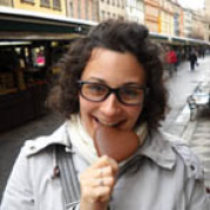Landscape Architecture for Landscape Architects › Forums › GENERAL DISCUSSION › Cemetary design
- This topic has 1 reply, 5 voices, and was last updated 14 years, 9 months ago by
 Paul Corsetti.
Paul Corsetti.
-
AuthorPosts
-
March 9, 2011 at 9:41 pm #164351
 Jelena HorvackiParticipant
Jelena HorvackiParticipantHey everyone! Can anyone help me with finding literature about cemetary design, organisation, rules? I’m researching it for my master degree and I really need help. If anyone can give me “direction” where can I find pdf books, some useful links or anything that will help me please send me. I’m doing my best to find it but unfortenately there is lack of literature about this topic.
March 10, 2011 at 4:57 pm #164366 Paul CorsettiParticipant
Paul CorsettiParticipantCheck out this forum from a couple years ago.. might be a starting point for you…
March 10, 2011 at 5:29 pm #164365 Jelena HorvackiParticipant
Jelena HorvackiParticipantI’ve already read something there. But thanks a lot, anyway. 🙂
March 10, 2011 at 6:36 pm #164364 Trace OneParticipant
Trace OneParticipantLots of history to cemetary design..In new england, always put them on the hilltops, for drainage. The beautiful Green-wood Cemetary in Brooklyn, with many famous people buried there, emblematic of the park -style of design that became popular at that time..
slave cemetaries – headstones were unmarked stones – some beautiful examples in Long Island.
How about Drew Gilpin Fausts, “This Republic of Suffering” about the creation of first-ever nationalized burial methods because of the number of dead in the civil war – lots of info in that book on how burial customs came in conflict with dying in battle, and how they tried to overcome that (carying little lockets of family, so they would be buried with family, letteres home of how the death of the loved one was a good one, so he would get to heaven….
And of course the well-documented creation of Arlington National Cemetary on the property of General Lee, a lasting insult to the Confederate troops, who I believe were NOT buried, but left on battlefields to rot..
good luck..
weird subject..Why don’t you take a weird tack, to make it easier on yourself, like how do you or your relatives want to be buried, and why, what design would make you happy..
The burial culture of Ancient Egypt, the catacombs of Rome, the use of the ‘escape bell’ – lots of trivia floating around in my head..Pet cemetary design may be easier to research..
March 10, 2011 at 6:46 pm #164363 Trace OneParticipant
Trace OneParticipanthttp://www.cprastudio.com/overview.htm
studio specializing in cemetaries – give them a call…
bon suerte!
March 10, 2011 at 8:05 pm #164362 Jelena HorvackiParticipant
Jelena HorvackiParticipantThe problem is that cemeteries in Serbia are mainly related to religion and people are not used to have cemeteries that looks like a park, wood cemeteries or something that is different. And I want to analyze this problem and show that this transformation and design of cemeteries could be a good and pleasant thing for people in my town and country. 🙂 Anyway, thank you for text me and helping me. It’ll definitely be useful. Especially those examples that you mentioned. 🙂
March 10, 2011 at 8:32 pm #164361 Paul CorsettiParticipant
Paul CorsettiParticipantJust trying to find some info through google, there is not much out there and you have to hit specific key words to find what you are looking for in a google search…
http://www.cityofboston.gov/parks/cemetery.asp
This link explains a very brief example of places you could use for case studies in the US… I know when i was in school they taught us that urban parks were unknown before the industrial revolution…In Europe, park spaces or green spaces existed as private grounds and were only places for the rich to use at their leisure. Most of the common class that worked for the rich, worked 7 days a week and after the industrial revolution came into full swing…the “work week” was invented… with a day off on Sunday! The working class used this day to be with family and go out of the house… cemeteries were the nearest green space in some of the larger urban areas and were used for picnics and that is when they began to use cemeteries as park space.
In New York, before Olmsted put Central Park together, cemeteries were used as the primary green space…
Again, this is what my profs taught us in University, I am trying to find a text book or some place that confirms this idea… lol … no luck on that… sorry
March 10, 2011 at 8:48 pm #164360 Paul CorsettiParticipant
Paul CorsettiParticipantAgain, not sure where his information is from either…but this summarizes what I learned in school.
Maybe look into Olmsted for reference of what he studied before he did Central Park…
March 10, 2011 at 8:57 pm #164359 Jelena HorvackiParticipant
Jelena HorvackiParticipantOk. I’ll try. Thanks 🙂
March 10, 2011 at 9:05 pm #164358 Trace OneParticipant
Trace OneParticipantGreen-Wood Cemetary, in Brooklyn, is precursor to Olmsted..you can look it up!
: )
March 10, 2011 at 9:09 pm #164357 Paul CorsettiParticipant
Paul CorsettiParticipantYes, he studied Green-Wood before he did Central Park… That is why I am saying to look at his information, perhaps there is more written about the lawn park cemeteries in books making reference to him and his work…
March 10, 2011 at 9:12 pm #164356 Jelena HorvackiParticipant
Jelena HorvackiParticipantPerfect guidelines! 🙂 That THE cemetery I could start from. I’ll write concept using all these information and see what my mentor will tell me about it.
March 10, 2011 at 10:53 pm #164355 mauiBobParticipant
mauiBobParticipantJelena, this would be a nice niche for landscape architects. Be the “Go To” expert on cemetary designs in the country. Not too many firms out there who are leaders in the field. I know there’s a lot of federal and state red tape regarding permits and plans in the United States. Or maybe, you just need to bury this idea and find another student project.
March 16, 2011 at 10:44 am #164354 Jelena HorvackiParticipant
Jelena HorvackiParticipantI found really interesting and useful things thanks to all of you. 🙂
March 16, 2011 at 2:14 pm #164353Tanya Olson
ParticipantThe latest – green or natural cemetaries. I found tons of information and books on cemetaries, burial landscapes, and cemetary design in the past when I searched….try Amazon.com and search ‘cemetary design’. Best of luck! One of my studio-mates did her thesis on cemetaries and used the mound-building native cultures of our area as a precident for a natural (non-burial) cemetary.
http://www.prairiewildernesscemetery.org/
http://en.wikipedia.org/wiki/Natural_burial
http://www.naturalburialresearchproject.group.shef.ac.uk/andy.html
-
AuthorPosts
- You must be logged in to reply to this topic.


